10 Tips to Extend Battery Life in iOS 13 and iPadOS 13
[the_ad id='1307']
Battery drain is the sort of issue that most of us have encountered at some point or the other. At times, the problem could be due to a hidden bug that seems to sneak in out of nowhere. On the other times, the issue could be due to power-hungry features that might be running unchecked. In either scenario, your device will find itself on the receiving end. If you are spending more time on charging your iPhone and less on using the device, you are already into the grip of the issue. Since this is a continuing problem, we are always on the hunt for ways that can help us contain this problem. And having dug deep into the software, we have come up with the best tips to extend battery life on the iPhone and iPad running iOS 13 or iPadOS 13, which can troubleshoot the problem straight away.
Best Tips to Extend Battery Life on iPhone and iPad
So, how are we going to resolve the rapid battery draining problem? Well, the latest iteration of iOS comes with a host of battery life-saving features. And if used smartly, they can rein in the issue right away. Not to mention, they do much more than just taking control of the power-hungry features. That all being said, let’s extend the iOS 13 power usage life by nabbing the culprits!
1. Enable Low Data Mode
Hold on for a moment before you start wondering why the heck you should enable low data mode when maximizing battery life on iPhone or iPad is your main priority! When you turn on this data-saving feature, it automatically disables all the power-hungry features like background app refresh, auto-download of apps and updates, video autoplay, and more. And by doing so, it not only saves plenty of data but also maximizes the battery life of your iPadOS 13 or iOS 13 devices.
1. To get going, open Settings app > Cellular/Mobile Data > Cellular/Mobile Data Options.
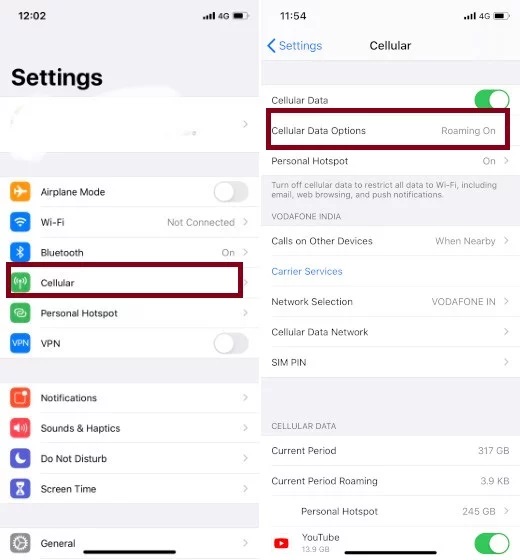
2. Now, turn on the switch for Low Data Mode.
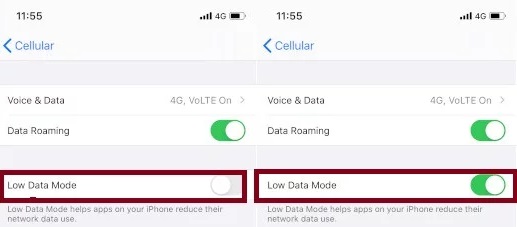
To find out more about how this new feature works, jump over here.
2. Make the Most of Dark Mode
After several years of wait, Apple has eventually rolled out a full-fledged Dark Mode for iPhone and iPad. Aside from enhancing the look of the entire interface, the feature also ensures the eyes feel comfortable while viewing content. As a result, even hours of Netflix binge-watching, reading long articles, or scrolling through your social media apps, don’t cause eye fatigue or straining. But the advantage exceeds well-beyond comforting the eyes.
According to a test conducted by PhoneBuff, turning on Dark Mode can extend the battery life of the iPhone by a whopping 30%. Yeah, you heard it right! It’s primarily because of the fact that the black pixels in the OLED panel (currently available on iPhone X, Xs, Xs Max, iPhone 11 Pro and 11 Pro Max) switch off and consume a lot less power. That means you get the best of both worlds: an easy-on-the-eyes screen and much-improved battery life.
To get started, open the Settings app on your iPhone or iPad and go to Display & Brightness > Dark. Do note that there is an “Automatic” switch which automatically enables Dark Mode at sunset and Light Mode at sunrise. Besides, it also offers you the option to set a custom schedule for the display change. To do so, tap on the Options > Custom Schedule. Then, set the schedule as desired.
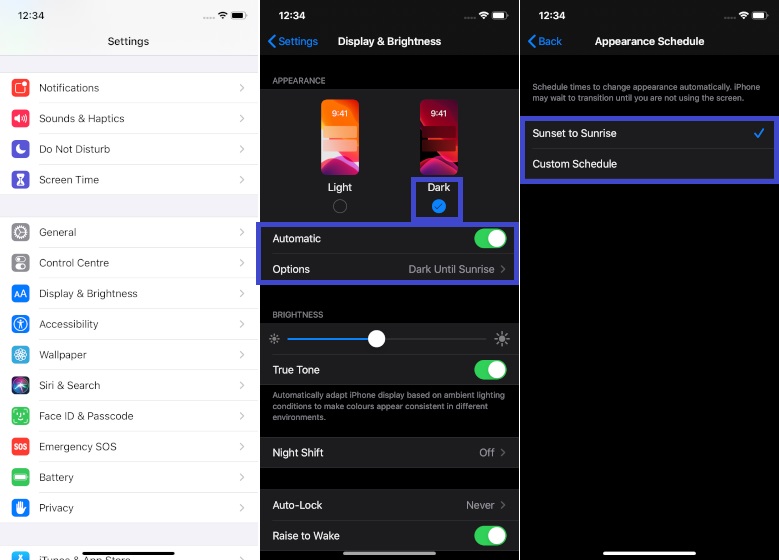
3. Get the Best Out of Optimized Battery Charging
To reduce battery aging, iOS 13 keeps a tab on your daily charging routine. And then the software waits to finish charging past 80% until you need to use the device. This feature not only extends the battery life span but also plays a vital role in improving battery life. So, make sure to keep the Optimized Battery Charging feature enabled. To do so, head over to Settings app > Battery > Battery Health > Optimised Battery Charging.

4. Automatically Close All Open Safari Tabs
Aside from being probably the most secure web browser, Safari is also highly efficient. Comparatively, Apple’s web browser requires fewer resources than other counterparts like Google Chrome. And therefore, it consumes way less battery than most web browsers. However, if you give it a free run, it can eat into plenty of power on your device. One of the smartest ways you can prevent the app from consuming a lot of power is by closing the open tabs automatically. With iOS 13 and iPadOS 13, you can configure the app to automatically clean up all the open tabs after one day. This way you can keep the app clutter-free and also help the device last longer.
To use this feature, head over to Settings app > Safari > Close Tabs and then choose the preferred option.
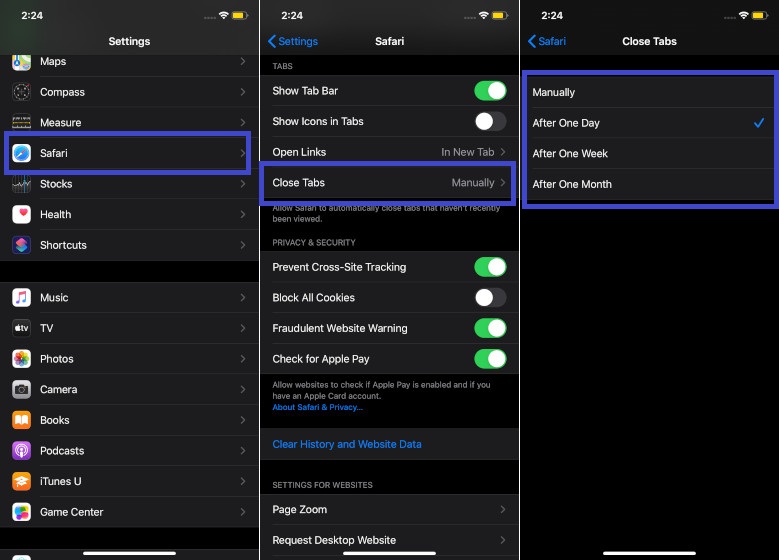
Just in case you are thinking this is a super cool Safari feature, let me tell you it is just tip of the iceberg as Apple’s web browser has got many notable features under the hood in iOS 13 and iPadOS 13. Want to put your hands on them all? Jump over here.
5. Share Location Only Once
Location tracking is one of the most power-hungry features that I have come across. And unless you take control of it, your device will continue to struggle to hold power for long. Thankfully, Apple has offered an option to share location with any apps only once. As a result, every time they need to access your location, they must ask for your permission. That’s not all, they must offer a valid reason behind tracking your location data. It can help not only the battery life but also improve security and privacy. When an app starts tracking your location, you will get an instant alert with multiple options. Choose Allow Once in the popup. The next time the app wants to pick up your location, it will once again have to ask your approval.

6. Disable Auto-Download of Apps and Updates
Agreed, auto download of apps and updates play a pivotal role in enhancing user-experience. After all, it’s always nice to automatically download the new purchases made on other connected devices and update apps so that they can always run smoothly. But, no one can deny the fact that it also consumes a large share of battery. So, at a time where your device is struggling to hold power, you should disable auto-download of apps and updates. Also, make sure to turn off the auto-download of music and Books as well as audiobooks.
To do that launch Settings app > iTunes & App Store > Under Automatic Downloads section, turn off the switch next to Music, Apps, Books & Audiobooks, and App Updates.
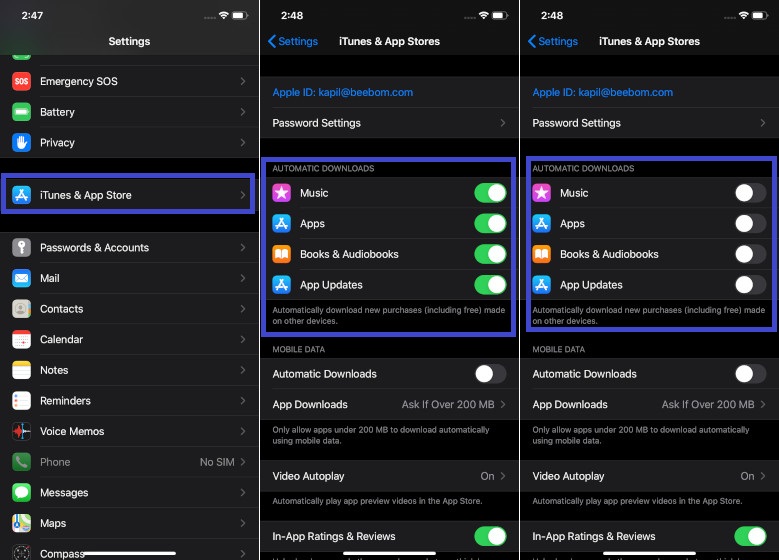
7. Disable Background App Refresh
“Background App Refresh” is well-known for consuming a ton of battery. And I don’t think you would be surprised to know that it also eats into plenty of data. So, if you find your iPhone draining a lot of power or just unable to meet your demand, turning off background app refresh completely would be a wise option. To disable it, launch Settings app > General > Background App Refresh. Then, choose Off.

8. Enable Low Power Mode
No roundup of the best battery life-saving tips for iPhone can be complete without “Low Power Mode”, can they? First introduced in iOS 9, it’s been one of my favorite features in iOS as it plays a vital role in extending the battery life. Even in 2019, it continues to be as relevant as it was in 2015. But before switching on the toggle, there are some trade-offs that you must keep in mind. It will temporarily reduce background activities such as downloads and mail fetch until your iPhone is sufficiently charged. Given the much-improved battery life in return, I think the trade-offs are worth. So, go for it as well!
To get started, open the Settings app on your iPhone> Battery > turn on the switch for Low Mode.
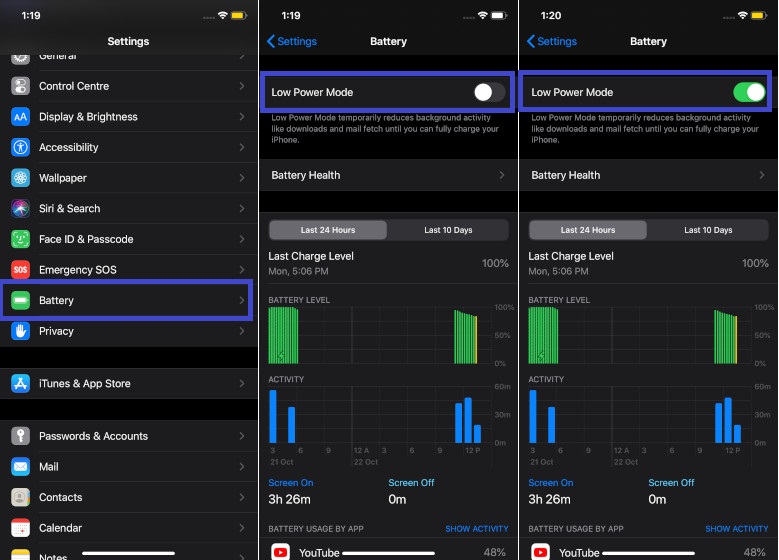
9. Upload Low-Quality Images to Safari
Uploading high-resolution photos and videos not only consumes a lot of data but also drains quite a lot of battery. And if you often have to upload media, do not fail to take advantage of this feature to upload low-quality images to Safari. It can speed up the uploading process; thereby saving a lot of power on your device.
1. First off, visit the site where you want to upload images. Then, click on the Choose/Upload file option and select the Photo Library in the menu.
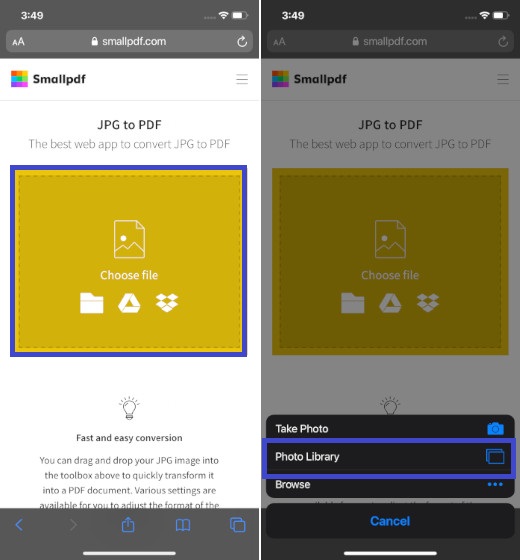
2. Now, select your images and then tap on Choose Image Size option at the bottom center of the screen.
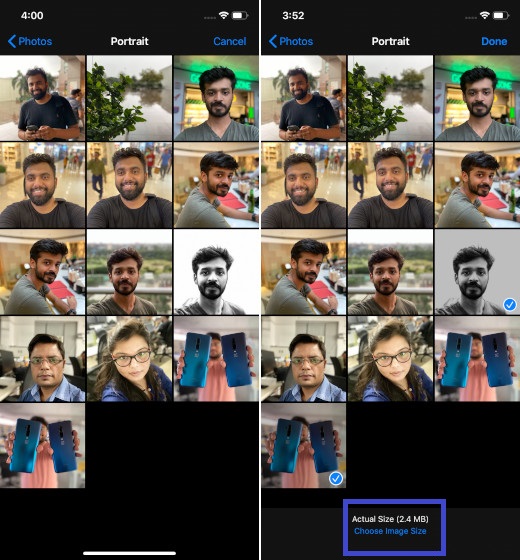
3. Finally, choose the preferred option like medium, large, small, and actual. Go with small or medium to save power and also data.

10. Make Sure to Share Low-Quality Images Via AirDrop
When everything is fine, I like to share original quality photos and videos. But when the device is low on power, I make sure to share low-quality images and clips via AirDrop. It helps my device last slightly longer. To find out how it works, open the Photos app on your device and then select the photos you want to share. After that, tap on the Share button and choose Options. Then, make sure the switch for All Photos Data is disabled. In the end, tap on Done to finish.
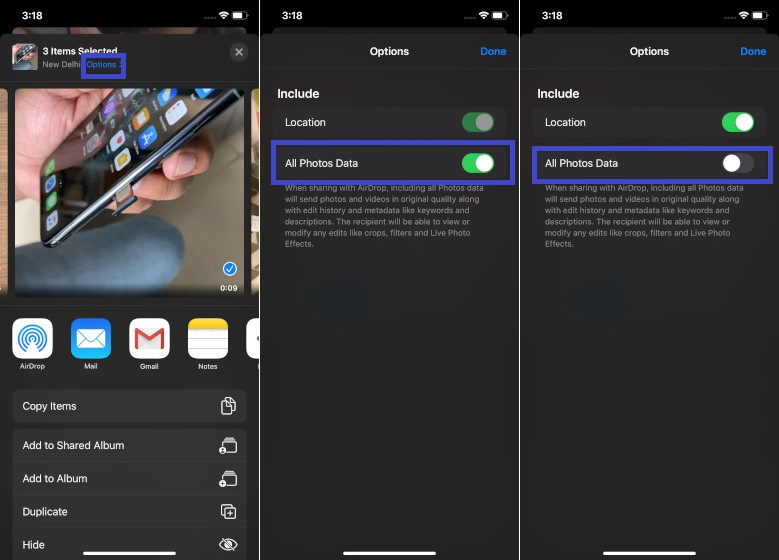
SEE ALSO: 10 Best iPhone 11, 11 Pro, and 11 Pro Max Camera Tips
Handy Tips to Extend iOS 13 and iPadOS 13 Battery Life…
Hopefully, your iPhone will now last longer between charges. Keep in mind, the problem is not with those power-sucking features but with the lack of gatekeeping. I mean, keep a track of all the features that are running on your device. And once you don’t need them, make sure to turn them off right away. Just in case, all the above-mentioned tricks don’t yield the right result, go for the software update as it’s well-known for fixing many adamant issues like the recently discovered “WiFi disconnects when iPhone is locked” problem. Now that the talk is over, share your feedback and the solutions that have worked for you in fixing the issue.
[the_ad id='1307']
Source link
[the_ad id='1307']